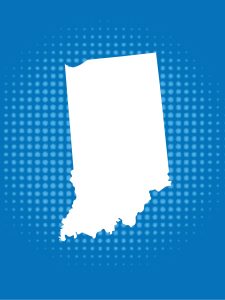President Lincoln was famously homeschooled in Indiana.
History
Indiana is in the midwestern United States. Homeschooling was first legalized in 1904 and then refined in 1985 through two key cases; State v. Peterman (1904) and Mazanec v. North Judson-San Pierre School Corporation (1985). Homeschooling existed long before the state legalized the practice; American President Abraham Lincoln was homeschooled in Indiana in the 1800’s.
Regulation
Indiana defines homeschooling as non-public and non-accredited schools where parents or guardians withdraw from public and non-public accredited school options to educate their students. Parents may homeschool their students, ages 7 to 18. The state offers one option for homeschooling. There is no requirement to register or report to the local school district or state. Parents may submit enrollment information once, and annual re-enrollment is not required.
Homeschool parents are required to keep accurate attendance records, which must be provided to the Secretary of Education or district superintendent upon request. The state recommends 180 days of instruction per year. There are no subject requirements, testing requirements, or parental education minimums.
Access for nonpublic school students, including homeschooled students, is not guaranteed to public school courses or extracurriculars. Individual districts may allow access. Homeschooled students who enroll in at least one public school course and who meet other requirements may participate in high school athletics. Access to special education services is unclear and appears to depend upon local school approval. Ind. Code § 20-33-2-12
State Data
Indiana cannot report homeschool participation for the state because parents are not required to report, and those who do, do so only once. Nevertheless, there is limited information on homeschool participation in the state through the U.S. Census estimates. According to the U.S. Census, around 5.4% of Indiana families homeschooled in the spring of 2020, and increased to 10.0% by the fall of 2020. These percentages are in line with national averages during that time. Based on U.S. Census data, our calculations indicate that about 6.88% of K-12 students in Indiana were homeschooled during the 2022-23 school year, and 7.58% during the 2023-24 school year. Due to survey changes, the data from 2020 reflects the percentage of households, while the data from following years reflects the percentage of students.
Cross-Sector Comparison
A cross-sector comparison cannot be calculated due to missing homeschool data.
School Choice Context
In addition to homeschooling, parents in Indiana have multiple school choice options. These include enrollment in traditional public with both inter- and intra-district choice, private, magnet, and charter schools. Indiana has four private school choice programs that include a tax credit for homeschool families worth about $1,800 per family.
Commentary
Indiana could improve educational opportunities for all nonpublic students by expanding access to courses and extracurriculars offered in the local public schools. Other states do this and many provide some funding for these offerings.

-
10.0% Families
Around 10.0% of families in Indiana homeschooled during the height of the pandemic (Fall 2020).
-
1904 Legalized
Homeschooling was legalized in 1904 in the state of Indiana.
-

-
More Information
10.0% Families
Around 10.0% of families in Indiana homeschooled during the height of the pandemic (Fall 2020).
1904 Legalized
Homeschooling was legalized in 1904 in the state of Indiana.

More Information
Last updated March 2025.